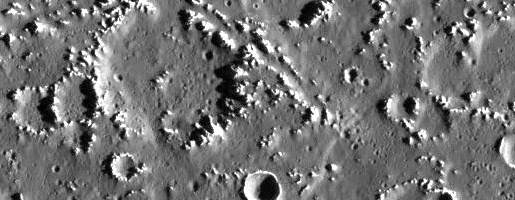 |
|||
|
Degraded
and eroded craters.
|
|||
| THE SURFACE OF CALLISTO | |||
| Callisto has a dark, rough terrain heavily populated with craters, similar to the moon Ganymede . Unlike Ganymede though, Callisto is dark and cratered all over, and has no major tectonic or volcanic provinces. Callisto also lacks the grooves and other structures found in Ganymede's dark regions. Seen from Earth, Callisto is the faintest of the Galilean satellites with an albedo of only 0.2. Analysis of the light reflected from Callisto shows that the surface is made of ice but contains a lot of impurities. Rock dust coats the surface. It is left behind when ice is vaporised by meteorite impacts. It is also deposited when ice is exposed on the surface and sublimates (turns directly from a solid to gas). In true-colour images of Callisto the surface looks brownish in colour. The brown colouration is thought to be contamination by meteoritic materials. | |||
 True colour view of the Asgard impact basin. |
 Craters and a blanket of rock dust. |
||
| The smooth edge of the moon's disk shows that the surface of Callisto has very little height variation and that there are no structures with significant relief. | |||
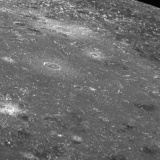 View towards the terminator. |
|||
| Callisto has no plains regions like our Moon or Mercury. Volcanism of any kind appears to be absent. The only real variation in the character of the surface is that some areas are slightly less heavily cratered than others. Such regions are common near large multi-ringed impact basins . The surface of Callisto doesn't seem to have undergone any major resurfacing. Callisto retains very little of its original heat which might otherwise have driven surface movement. There is no sign of surface deformation occurring in the past like that witnessed on Europa and Ganymede. Furthermore Callisto orbits 1.9 million kilometres from Jupiter, far beyond the orbit of Ganymede, so Callisto is barely perturbed by the other Galilean satellites and is not tidally heated. | |||
| Composition | |||
| Infra-red images, as obtained by Galileo, suggest that Callisto's dark surface is caused by a layer of dust. Such a layer is removed during a crater impact, to reveal underlying fresher bright ice. Both the optical and infra-red views of Lofn crater, for example, clearly show the different composition of the material excavated during impact. In the infra-red images, red represents areas richer in ice, whilst blue represents material that is a mixture of ice and dust. Analysis of infra-red data has identified carbon and sulphur as two possible materials making up Callisto's dust. Furthermore, there appears to be a chemical variation across Callisto's surface, represented as a subtle colour variation. This can be explained as material arriving on Callisto's surface from space, collected as the moon travels in its orbit. Dust clouds have already been detected around Callisto, Europa, and Ganymede. | |||
 Lofn crater on Callisto's southern hemisphere. |
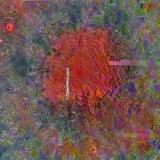 Lofn crater composition. |
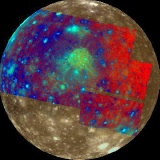 Surface composition showing variation across the hemisphere. |
|
| Craters | |||
| The rate of cratering (sometimes called the crater 'flux') near Jupiter may have been slightly lower than within the inner Solar System. There is also a general lack of very large craters. In some regions, the density of craters is similar to that of the lunar highlands. | |||
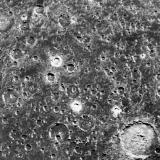 Keelut crater and dense cratering in southern Callisto. |
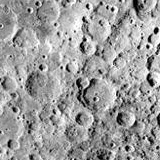 The lunar farside. |
||
| The high density of craters is therefore a very good indication of the great age of the surface. It may have survived unmodified (apart from the accumulation of craters) for four thousand million years. Indeed, Callisto may have the oldest surface in the Solar System. | |||
| It is possible to estimate the proportion of craters which have been caused by asteroids originating within the Jupiter system. It involves looking at the distribution of craters with respect to the leading hemisphere, that facing the direction of travel (the opposite face is the called trailing hemisphere). Craters over 60 km across are more common nearer the centre of the leading hemisphere, while smaller craters are evenly distributed. This shows that only the larger impact craters were caused by objects from outside the Jupiter system. | |||
| Very small craters seem to be missing from the surface of Callisto. It was expected that the high resolution Galileo pictures would reveal smaller craters just as looking closer at our Moon reveals smaller and smaller craters. Somehow these have been erased. They may have flowed back into the surface more easily and more quickly than the larger craters. Alternatively, they may simply have been covered by fine debris. Some craters are simply bright splodges similar to the palimpsests on Ganymede. Ice at low temperature behaves like rock, but warmer ice may have flowed gradually like a glacier. The crater topography deforms under its own weight in a process called viscous relaxation. This could explain why there are few big craters.There appear to be a greater number of younger sharper craters. It is now colder on Callisto, which means that new craters will remain fresh looking and not degrade like their predecessors. The brighter craters are thought to be younger. Ice churned up on the surface has not completely vaporised. | |||
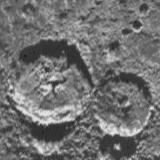 Younger, sharper craters near the south pole of Callisto. |
|||
| Crater erosion | |||
| There appear to be erosion forces at work on Callisto's surface. Many craters show different stages of degradation. The crater Randver for example has suffered from landslides. Landslides occur when a crater wall falls due to gravity. The failure of a crater wall could also be triggered by nearby meteorite impacts. Some landslides have travelled several kilometres from collapsing crater walls, which is unexpected as Callisto has no water or atmosphere that could aid long-distance travel. However, the landslide material may consist of very fine grains which become subject to electrostatic forces, thereby counteracting gravity and extending the distance travelled. | |||
 Randver crater and landslides. |
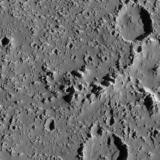 Crater wall failure and long-distance landslides. |
||
| Apart from the force of gravity, and meteoritic impact, there may be other process at work causing degradation of the surface. Some features on Callisto are not entirely circular like most craters, and one theory is that they may be the result of sub-surface processes. Ice under the surface may evaporate to space, causing the ground above to collapse and form pits. This is still only a theory, as the non-circular features may merely be eroded secondary impact craters, formed by the ejecta from a larger crater. | |||
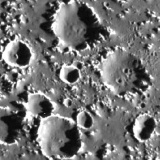 Erosion features caused by sub-surface processes. |
|||
| Degradation of Callisto's craters is more severe than found on our Moon, possibly because resurfacing by impact ejecta is a more efficient process on Callisto. However, not all the impact ejecta falls back to the surface. Some of Callisto's surface material is kicked to such a high speed by impacts that it achieves escape velocity. The escaped dust then remains in orbit around Jupiter. The bombardment of a moon and subsequent formation of an orbital dust cloud has been detected at Ganymede and Europa. Furthermore, structure within the Jovian ring system can also be attributed to escaped impact ejecta. | |||
 Degraded craters and a blanket of dust. |
|||
| Crater chains | |||
| There are at least 12 crater chains on Callisto (Ganymede has just three). Gipul Catena in the north polar region of Callisto is the most prominent. It is about 600 km long and the craters are each about 40 km across. | |||
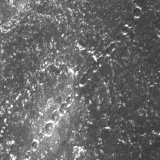 Crater chain Svol Catena crossing Skuld crater. |
|||
| Closer inspection of the craters forming part of a crater chain shows that material has fallen down the slopes of the craters. The rims of the craters are brighter than the surrounding terrain, as downslope collapse has exposed fresh ice that isn't covered by dust. The smoothness of the walls indicates that an erosion process has been at work for many millions of years. | |||
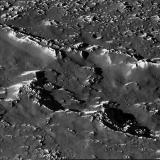 Galileo high-resolution view of part of a crater chain. |
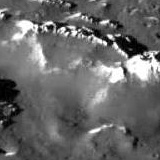 The eroded, smooth walls of a crater chain capped with fresh ice. |
||
| Crater chains are almost certainly formed by a string of meteorites, travelling together and then striking the surface in a line. A comet comprising a loose assortment of stones bound by ice may have been disrupted by gravitational forces and broken up. Comet Shoemaker-Levy 9 suffered the same fate before colliding with Jupiter. | |||
| Basins | |||
| As well as the impact craters, there are also two large impact "basins". The largest is Valhalla, with a central bright area 600km wide and multiple rings up to 4000 km across. The second largest multi-ringed impact basin is Asgard, about 1600km wide. Similar multi-ringed impact basins are Mare Orientale on the Moon and Caloris Basin on Mercury. | |||
| More about Callisto's impact basins | |||
|
|
|||